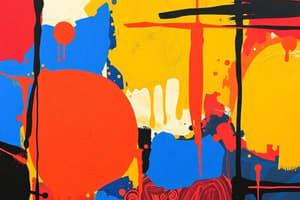Podcast
Questions and Answers
How did the Arabs acquire the knowledge of papermaking?
How did the Arabs acquire the knowledge of papermaking?
- From Chinese prisoners. (correct)
- Through independent invention.
- Through trade with Japan.
- By discovering ancient Egyptian texts.
Which of these materials was used by Tsai Lun to make paper?
Which of these materials was used by Tsai Lun to make paper?
- Wood pulp.
- Soaked rags. (correct)
- Papyrus reeds.
- Animal hides.
Which country was the last to receive the art of papermaking?
Which country was the last to receive the art of papermaking?
- Japan
- Morocco
- England (correct)
- Spain
What is the connection between the ancient Egyptian papyrus and modern paper?
What is the connection between the ancient Egyptian papyrus and modern paper?
What was Tsai Lun's role in the Chinese government when he invented paper?
What was Tsai Lun's role in the Chinese government when he invented paper?
How did papermaking spread from the Islamic world into Europe?
How did papermaking spread from the Islamic world into Europe?
Which raw material did the Japanese pioneer in using for papermaking?
Which raw material did the Japanese pioneer in using for papermaking?
What can be inferred about the spread of papermaking?
What can be inferred about the spread of papermaking?
What is the main difference between ancient Egyptian papyrus and the paper invented by Tsai Lun?
What is the main difference between ancient Egyptian papyrus and the paper invented by Tsai Lun?
What key advancement in papermaking is attributed to Japan?
What key advancement in papermaking is attributed to Japan?
Which of the following regions served as a crucial intermediary in the spread of papermaking between China and Europe?
Which of the following regions served as a crucial intermediary in the spread of papermaking between China and Europe?
In what way is the method of papermaking developed by Tsai Lun similar to modern methods?
In what way is the method of papermaking developed by Tsai Lun similar to modern methods?
What action did the Chinese take to control the knowledge of papermaking?
What action did the Chinese take to control the knowledge of papermaking?
Before England, which European country first encountered the art of papermaking?
Before England, which European country first encountered the art of papermaking?
What does the timeline of papermaking's spread indicate about technology diffusion in ancient times?
What does the timeline of papermaking's spread indicate about technology diffusion in ancient times?
Why was the city of Samarkand significant in the history of papermaking?
Why was the city of Samarkand significant in the history of papermaking?
Which country's innovation directly led to a more sustainable method of papermaking?
Which country's innovation directly led to a more sustainable method of papermaking?
How did the geographical location of Morocco influence the spread of papermaking into Europe?
How did the geographical location of Morocco influence the spread of papermaking into Europe?
What conclusion can be drawn about the importance of papermaking based on its history?
What conclusion can be drawn about the importance of papermaking based on its history?
Which factor was most important in transforming papermaking from a localized craft to a global industry?
Which factor was most important in transforming papermaking from a localized craft to a global industry?
Flashcards
What is Papyrus?
What is Papyrus?
The earliest form of paper, made from reeds that grew next to the River Nile.
Who was Tsai Lun?
Who was Tsai Lun?
A Chinese government minister who invented paper in AD105.
How did Tsai Lun make paper?
How did Tsai Lun make paper?
Soaking rags in water, rolling the soaked rags flat, and letting the mixture dry.
Who were the first to make paper out of wood?
Who were the first to make paper out of wood?
Signup and view all the flashcards
Who were the Arabs?
Who were the Arabs?
Signup and view all the flashcards
What was the spread of papermaking?
What was the spread of papermaking?
Signup and view all the flashcards
Study Notes
- The Ancient Egyptians created the earliest form of paper, papyrus, around 2,500BC, using reeds from the Nile River.
- The term "paper" is derived from "papyrus," though the materials differ significantly.
- In AD105, Tsai Lun, a government minister in China, invented paper as we know it.
- Tsai Lun's method involved soaking rags in water, flattening them, and allowing them to dry, similar to modern paper-making.
- The Chinese kept paper-making a secret for centuries.
- By AD610, the Japanese had learned to make paper, pioneering the use of wood.
- In AD751, the Arabs acquired the paper-making technique from Chinese prisoners and began production in Samarkand
- Paper production spread throughout the Islamic world to cities like Baghdad and Damascus.
- By AD1100, paper-making reached Morocco and then spread to Europe through Spain.
- Paper manufacturing did not reach England until the 19th century.
Studying That Suits You
Use AI to generate personalized quizzes and flashcards to suit your learning preferences.




